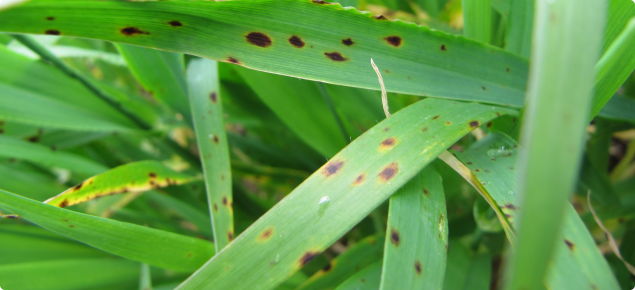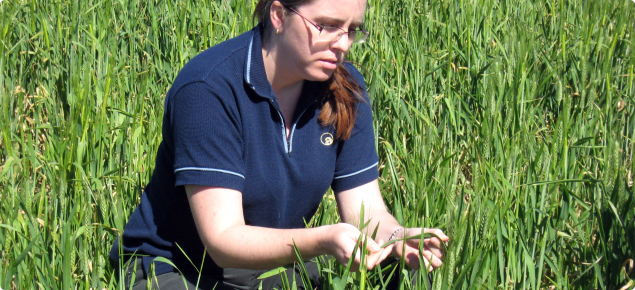When are crops at greatest risk?
Yield and quality losses are likely to be greatest when crops are exposed to early infection and seasonal conditions favour ongoing development of disease into the upper canopy of the crop.
- Sowing a susceptible variety onto or adjacent to barley stubble, particularly if the previous crop was infected, exposes the new crop to greatest disease pressure. This scenario occurs with consecutive plantings of herbicide tolerant varieties such as Spartacus CL or Maximus CL.
- Seasons with warm-mild temperatures and frequent rainfall facilitate the production of spores and disease development on leaves.
- Early sowing allows early establishment of disease and exposes the upper canopy of the crop to disease favourable conditions for the longest period.
- When spring conditions are dry and do not favour disease development, yield losses may not occur despite significant early disease development
What impact does spot form net blotch have?
SFNB can cause losses in both yield and grain quality.
In a 2016 review of more than 25 DPIRD trials, yield losses from SFNB infection in susceptible varieties occurred in more than half (58%) of trials analysed (predominantly HRZ trials). Grain yield gain from SFNB control ranged from 0.2-2.2t/ha (5-59%) of the untreated yield. Grain screenings reduced by a third and there were also improvements in grain weight, hectolitre, brightness and protein levels.
Yield loss was highly related to rainfall, particularly rainfall and number of rainy days in spring, with responses to fungicide application of 10-50% being seen in 70% of high rainfall sites compared to only 5-6% response in less than 50% of lower rainfall sites. (A 2021 metanalysis of DPIRD LRZ trials has shown that economic response to fungicide is unlikely and unreliable in lower rainfall environments).
Growers in the medium and low rainfall areas need to take the spring rainfall outlook into account when deciding if a fungicide application is necessary – in a dry spring there is no additional benefit from fungicide application.
Is the disease getting more severe?
Widespread adoption of susceptible varieties has led to more frequent occurrence of SFNB. When these varieties are cropped continuously in the same paddock the disease risk increases dramatically.
How do I manage SFNB?
Rotation
Avoid growing barley in successive years in the same paddock as most inoculum survives in stubble.
Variety choice
Where possible avoid S and VS varieties. Do not sow S or VS varieties onto barley stubble, this is a maximum risk scenario (for example, do not sow continuous Spartacus CL).
See variety disease ratings in the latest Barley variety guide.
Burn stubble
Burning the stubble will lower the inoculum level reducing the risk of early season infection. However, unless the burn gets every piece of straw including the crowns there will still be some carryover of inoculum.
Sowing later may help
Later sowing, towards the end of the sowing program, may reduce the infection risk because of the reduced period of exposure to inoculum. The impact of this approach will be dependent on seasonal conditions following emergence and can have agronomic yield impacts.
Ensure correct disease identification
It is important to remember that abiotic factors such as nutrient deficiencies / toxicities or adverse weather conditions can also cause abnormalities in barley leaves. Some barley genotypes exhibit varying degrees of physiological spotting on leaves which can also be confused with disease symptoms.
An important starting point in disease management is correct identification as diseases differ in their best management strategies.
Further assistance with disease identification can be obtained from DDLS - Plant pathology services.
Apply a fungicide
Seed dressing or in-furrow fungicides
The seed dressing fungicide Systiva® (fluxapyroxad) or in-furrow applied fungicide Uniform® (azoxystrobin) are registered for the control of SFNB. They provide systemic protection and can significantly reduce SFNB infection, particularly during seedling and tillering stage, and often up to booting. In seasons with a dry spring, this may not result in significant yield response.
Details on which seed dressing active ingredients are registered for SFNB can be found at Seed dressing and in-furrow fungicides for cereals in Western Australia.
Foliar fungicides
Registered foliar fungicides suppress disease development; very seldom do they provide complete protection, and renewed development of SFNB may be seen again during the growing season. The length of protection is dependent on the product, rate and disease pressure.
In environments with wet spring conditions, significant yield responses to one or two spray programs can regularly give economic returns.
In lower rainfall environments with drier springs and relatively short grain filling periods, the likelihood of significant yield or grain quality responses to SFNB control is reduced significantly and economic returns are unreliable and less likely in these environments.
In regions where economic response to fungicide is likely, you need to spray before SFNB levels reach 5% leaf area infection. The most consistent responses for a first fungicide application timing have been recorded with fungicide application around stem elongation (Z30-31).
In regions or seasons where spring rainfall will support disease development then applications around flag leaf - booting can show significant yield and quality benefits.
Details on which foliar fungicide active ingredients are registered for SFNB can be found at Registered foliar fungicides for cereals in Western Australia.
Seedling sprays
Applications before stem extension (seedling - tillering) provide disease control but will need additional follow up application for continued control and yield response. They are less likely to be effective as a single application than later sprays because inoculum continues to be produced on stubble and new unprotected leaves emerge continuously.
In some cases, especially if the forecast for the following 2–3 weeks is for wet conditions, fungicide application at mid-late tillering of infected crops may be warranted but will usually require follow up applications.
Which foliar fungicide?
A range of Group 3, 7 and 11 fungicides are registered for SFNB control in barley.
Resistance to some Group 3 (DMI) and Group 7 (SDHI) fungicides has been identified in SFNB in WA.
What rate?
The efficiency and length of control is better with higher label rates. Do not use rates lower than label recommendations; disease control will be unsatisfactory.
When to respray
The effect of foliar fungicides may only last 2-4 weeks, depending on the rates used. Therefore, if disease begins to build up to damaging levels again in the mid-canopy, a follow up application at late stem extension to booting is recommended where favourable spring conditions are expected.
Crop nutrition
Appropriate levels of nitrogen (N) and potassium (K) nutrition to maintain crop health may help minimise disease impact.
Research results
DPIRD research, co-funded by Grains Research and Development Corporation, produces comprehensive data to enable the grains industry to develop sound strategies for managing spot-type net blotch in barley crops. DPIRD research results are available under 'External links' on the right hand side.


